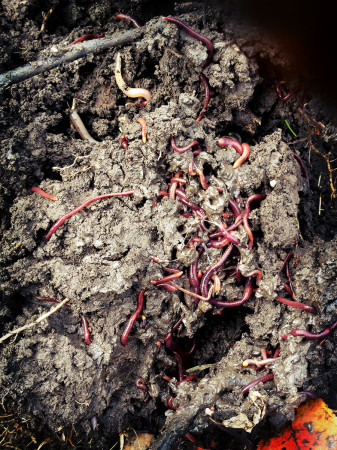My Winter Composting Experiment
I’ve been working on this experiment. Instead of composting in a pile or a bin, Ive been throwing my garbage straight in the gardens. Have I done the unthinkable? I’ll tell you how and why I’ve been doing this.
This summer we converted an old compost bin into a new garden. It was kind of a smelly eyesore and placed right along the path where customers walk to get to the nursery. It had to go. But something kind of amazing happened before I decided what that area should be… The seeds from last years tomatoes sprouted and grew 10 times better than in the vegetable garden. So I let em GO, I didnt even stake them, just let nature do its thing.
This was my most exciting experience learning about good soil. Because everything I put in that garden grew faster than ribbon grass (Jon will get the joke). And the worms, oh the worms. you gotta see them.
Recently, we learned about Geoff Lawton. Sustainable permaculture? food forest? I dont have much experience with either, but these words give me a little jolt every time I hear them. And the information is just as exciting. In one of his permaculture videos, Geoff and his students practice what they call ‘chop and drop’. Its kinda like permission to be a lazy slob. Ive been freed! After you’ve pruned or harvested the plant, you chop up the debris, then drop it right below the plant you pruned it from. I am so DOWN for that.
But freedom is harder than you think!
We have this human NEED to CLEAN UP after ourselves. We like things neat and tidy, compartmentalized, fit in its right category. But nature doesn’t do it that way, and frankly, nature doesn’t appreciate it either. Nature litters all day long! Leaves and branches fall, animals poop, and the wind blows all that garbage around. You’d think nature would be a terrible neighbor. Yet it comes out BEAUTIFULLY! All that stuff we’re tidying up, packing neatly in yard bags and paying for removal? It all makes incredibly rich organic soil. So keep your leaves, grass clippings, yard debris… and dump them back into your garden.
And dont stop there!
Kitchen waste can go straight in your garden too! Oh, you’re shaking your head now… ‘No way am I throwing garbage in my garden’. uhhm, did you see the worms??? ok, i’ll show you!
This happened because I couldn’t get under my tomato plant to clean out all the tomatoes that rotted on the ground. What I would have never guessed in a thousand years was, what a drastic improvement rotten tomatoes could make!
So here’s the experiment Im working on.
THE ZERO GARBAGE Project.
The goal of this project is to reduce the volume sent to the landfill while creating the richest soil my garden has ever seen. Why should they get the good stuff, right? 😉
Every sliver of compostable kitchen scrap now goes straight into the garden. Ideally what’s left, should be mostly recyclable. I’ll tell ya, I feel a little naughty, standing at my doorway in the middle of December, tossing a banana peel into the garden. But its for a CAUSE! And since no ones out there looking at the gardens, winter is the perfect time to start composting. Even though it wont do much decomposing in the winter, I believe it should have enough time to break down in early spring, before the summer planting months arrive.
ok! so what goes in?
Vegetable scraps. Fruit. Herbs. Popcorn. Coffee and coffee filters. Tea bags. Napkins and Paper towels. Shredded paper, newspaper and cardboard. Stale bread and burnt toast. Dead flower arrangements. Pencil shavings and sawdust. Basically anything organic that breaks down. heres more of what goes in
now, what stays out?
- Kitty litter, dog business. I read that feces of carnivores might contain disease organisms. ewww. i dont want that anywere near my tomatoes.
- Lime, coal, charcoal. May be toxic to plants or change the pH in a way that stops decomposition.
- Meat, fat, grease, oil, bones. This is a little controversial. Some people say yes, go for it. Other say that fat and grease dont break down. Not only do they not break down, they coat everything else so that wont break down either.
- Dairy products like milk, butter, cheese, ice cream or yogurt. This one is iffy. Its said the pungent odor attracts pests, but can be hidden in the middle of a compost pile to mask it. For our purposes, milk would just be gross, so lets skip it.
- Heres more of what stays out
COOL COMPOSTING TIP! When the Mess Becomes Unbearable.
It really does look bad when garbage piles up, so I have been covering it. We have a pile of finished compost and a pile of woodchips here at the nursery. Good materials to have on hand. I’ll sprinkle light layers on top. This not only covers the mess, but it helps it break down faster! I’ve read of people digging a hole or a trench, throwing scraps in, then covering lightly with the dirt from the hole.
I implore you, I EMPOWER you to throw your garbage straight into the garden. It doesn’t feel terribly right at first, but I imagine the rebellious attitude I’ll boast, knowing that what I’m doing is the best thing for my garden.
UPDATE: Summer 2015
Ok, well, everything decomposed well before planting time, so that was a plus. BUT I did not really see much improvement in plant growth. Because my garden area is large, I believe that I needed MUCH MORE compost to create great garden soil. More than I could consume in a winter. Now. If I were to have added a thick layer of grass clippings, and then another thick layer of woodchips to this soil, we might see an improvement. It takes quite a bit of compost to change the biology of soil enough to see vast increases in plant growth. Since grass clippings aren’t available in the spring, I can add them in the fall when the garden is spent. Add kitchen scraps all winter. Then early spring cover everything with woodchips. Mel Bartholemew, the square foot gardening genius, recommends that compost contain at least 4 different materials. The experiment was worth doing, and I enjoyed sending less waste the the garbage dump. Plus, I’ve learned what to do next year!

